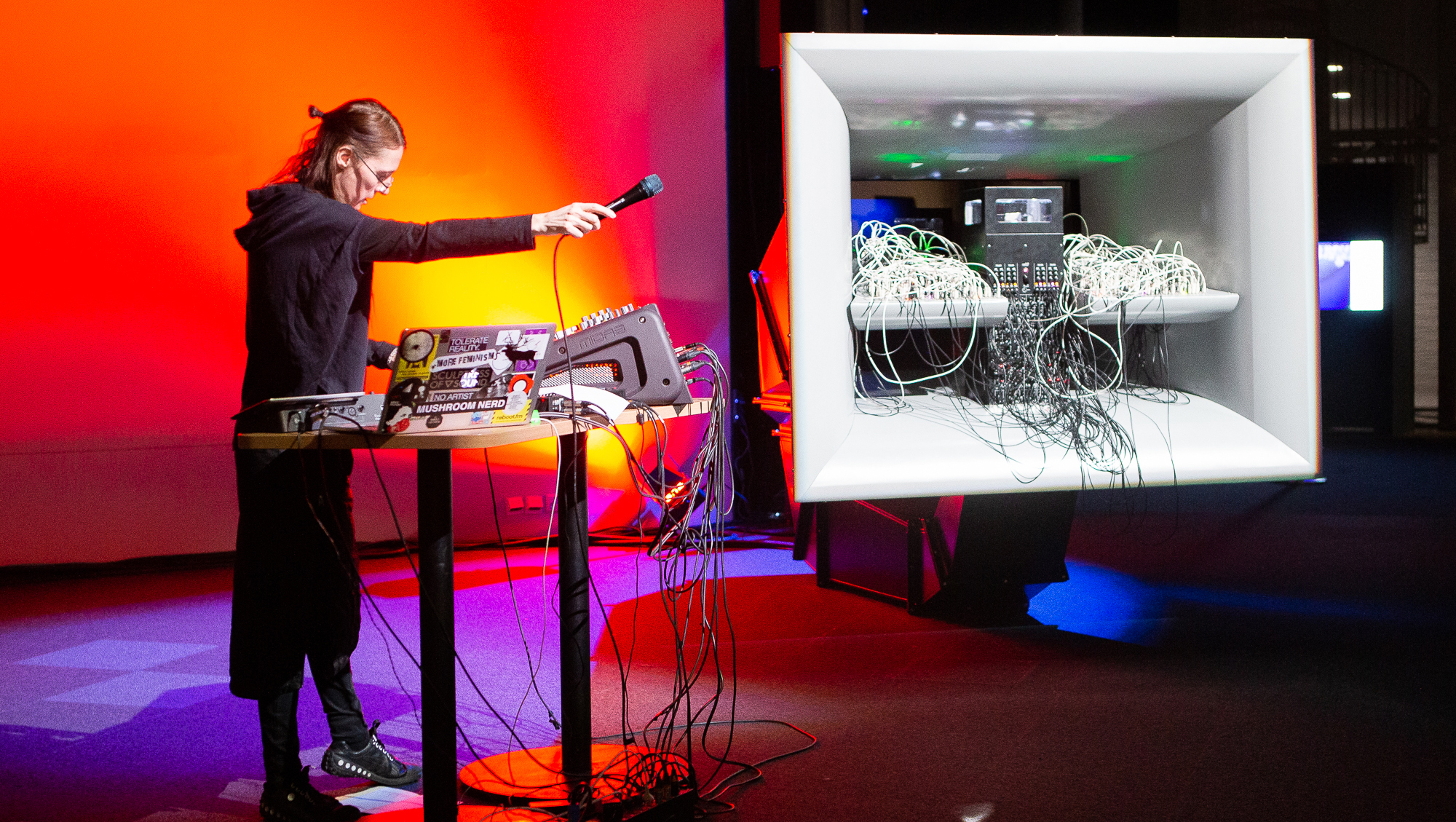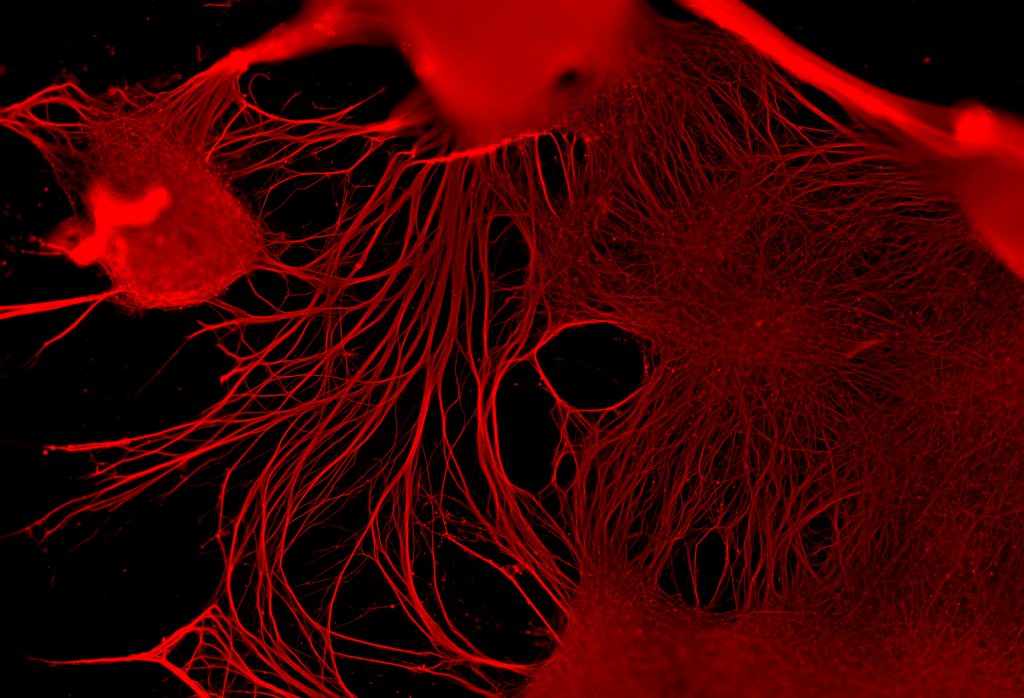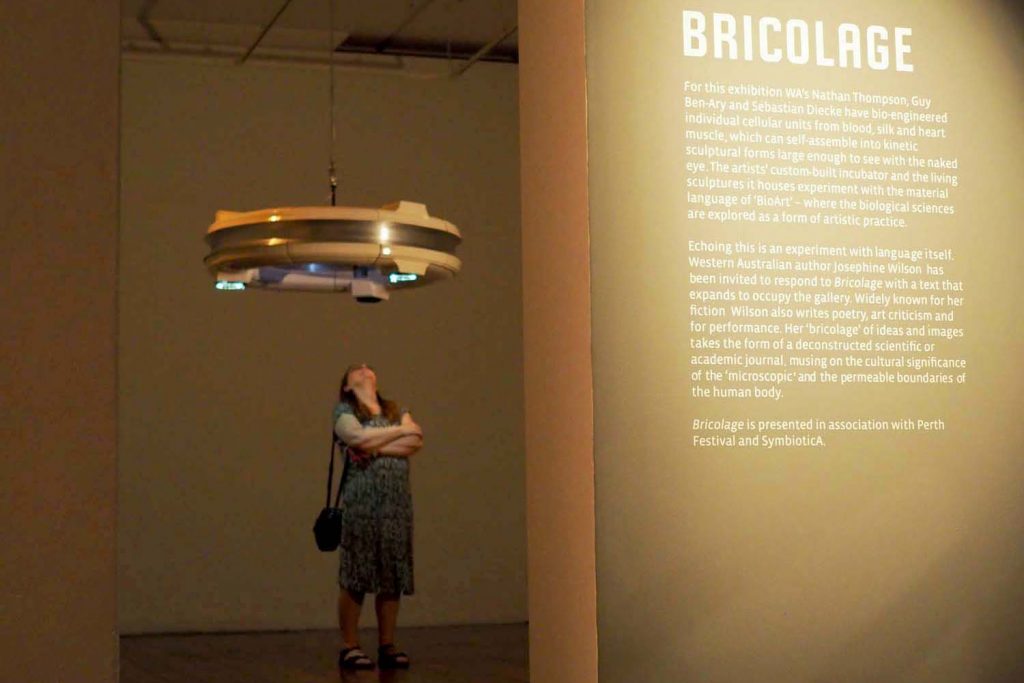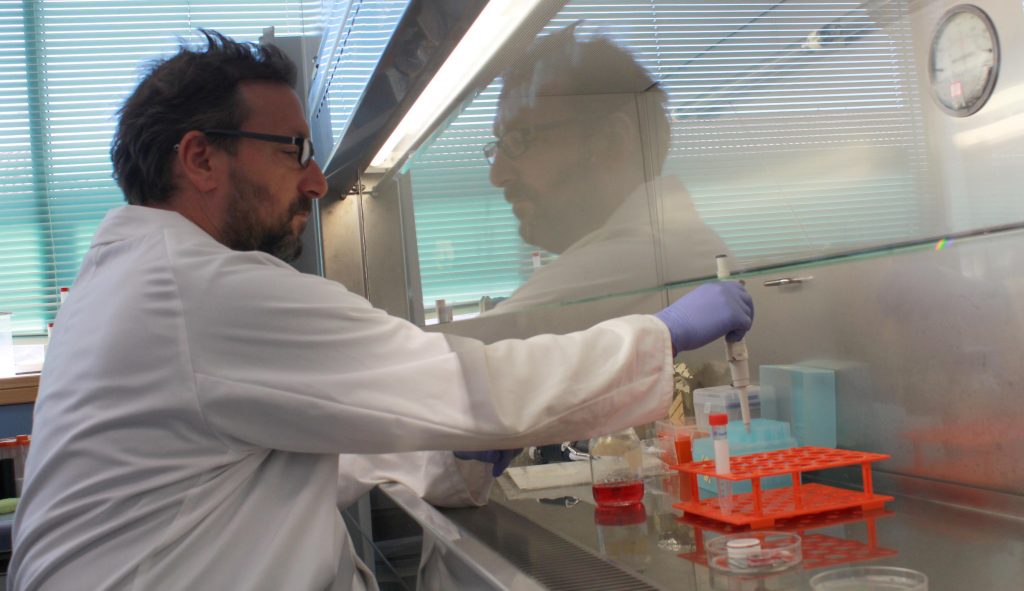
Guy Ben-Ary & Nathan Thompson, cellF, a surrogate performer, improvisation with AGF in the Science Centre Heureka, Helsinki 2019. Photograph Mari Keski-Korsu.
Dr Naomi Hunter in conversation with ANAT Ideate resident Guy Ben-Ary
Radio Adelaide’s Festival City Producer, Dr Naomi Hunter talked to ANAT Ideate resident Guy Ben-Ary about his project with Nathan Thompson researching the possibility of bioengineering visual and auditory organoids, to operate as input mechanisms for surrogate performers.
Hear the whole conversation… or read an extract and transcript below.
Naomi: So next on the show we will be talking to Guy Ben-Ary. And Guy is actually working with another West Australian artist, Nathan Thompson, who unfortunately couldn’t join us today, but they will be researching the possibility of bioengineering visual and auditory organoids, to operate as input mechanisms for surrogate performers. Welcome to the show, Guy.
Guy: Thank you very much. Thank you for having me.
Naomi: So that is an awfully big summary in one sentence, and I would love you to break that down for us just a little bit, and perhaps we could start with your own creative practice. What you have been doing in the past, and work our way up to this project.
Guy: Yeah, so I think that’s the right way of doing it, because this proposal, the proposal that we came to ANAT or the residency that we’re doing with ANAT is a continuation of a few projects and concepts that we’ve been developing and establishing in the last 20 years really. But the last two were a bit more relevant and would help to explain those concepts. Nathan and myself are artists in residence and researchers with SymbioticA, the centre for excellence for biological arts within the University of Western Australia. I’ve been with SymbioticA for the last 20 years, and Nathan is with us for the last six year, and we work in the labs of SymbioticA. Our practice, our we would define it as focused on bio-art, biological art, and robotic art. Most of Nathan and my projects are looking at biology and biological technologies and the future of these technologies and how they’re going to affect us socially. But also we’re looking at the interface of these technologies to robotic technologies as well. Most of the work is bio-robotic work, trying to poke and probe and play, be playful and critique these technologies in order to see and suggest contestable futures through our work, through the work gallery, and generate some sort of discussion with the viewers about our future.
Naomi: It would be great to hear a little bit about a precursor to the current work, which was called cellF. And I believe it was the world’s first neural synthesiser.
Guy: With cellF, it was almost like cellF, C-E-L-L-F, it’s almost like a progression of most of the things that I’ve been doing in the last 20 years. And in cellF, what I did is it’s basically my self-portrait.
Naomi: I’m pretty sure this is not your standard self-portrait. Can you explain what you mean by that?
Guy: I took my own neurons. I used sensor technology to reprogram my skin cells to neurons. And then I connected those neurons to an array of analogue modular synthesisers.
Naomi: So basically, you created an organic network that could output data, attached it to a synthesiser, but how did the performances work?

Guy Ben-Ary’s neurons, at day 14 for differentiation, grown for ‘cellF’. Photograph Guy Ben-Ary.
Guy: You know, we invited human musicians to play with this cybernetic musician in a way that the human music was sent to the neurons as simulation. The neurons responded to those stimulations and in return controlled, or sent control signals to the synthesisers, and this way we had some sort of a feedback loop between the human musicians and the neurons.
Naomi: So what we’re talking about here is creating like an organic processor?
Guy: Exactly. So we’re talking about creating the organic processor, and that was the focus of cellF. And we also kind of realised what we actually created is what we refer to as the surrogate performer. A performer that embodies the ability to produce and analyse and generate creative output in response to sensory stimuli. This surrogate performer has a direct biological link to the donor. In that case, cellF had the link to myself.
After cellF, we developed Bricolage. We focused more on the visceral movement and inherent visceral characteristics of a cardiomyocytes, heart muscle cells that twitch and move spontaneously in…
Naomi: OK. Is that like the pacemaker cells?
Guy: Well, they’re part of them, this is what makes them kind of beat. So when you grow cardiomyocytes in a petri dish, and you look down the microscope you really find you can see them twitch and move. It’s quite an amazing sight. You can’t really describe the feeling of actually seeing them do it.
Naomi: And again, where did those cells come from for this particular project? For cellF, it was from yourself.
Guy: And that’s kind of the idea of Bricolage. In Bricolage we worked with established scientists that actually helped us reprogram a drop of blood from a donor, we took the blood cells and reprogrammed them to become stem cells [inaudible, 07:22] and then we differentiated them to become cardiomyocytes. So really, in Bricolage, the starting point was a drop of blood and the end point was automatons. So what we did is we took the cardiomyocytes, the heart muscle cells, and we grew them onto bodies that are made onto silk. And we used silk for their inherent cultural meaning, but also for the fact that it’s being commonly used these days as a biomaterial.
Naomi: And we’re still talking about in vitro, so we’re talking about petri dish sized happenings here.
Guy: Absolutely, absolutely. The cardiomyocytes, the heart muscle cells, grew over the bodies made out of silk, and propelled those bodies and manipulated them in a way that those structures were moving in real time, actually swimming, quite definedly in the media and we managed to grow them big enough so that we could actually see them. Viewers could actually see them with their naked eye, rather than, it was unmediated by screens or cameras or any other kind of means of technology. Automatons had a really strong physical and visceral presence in the gallery, where people could actually see them and engage with them. And we refer to that as again, micro-performance, where those automatons were performing to the viewers. And here, we haven’t used the processor or the in vitro-intelligence networks that I was talking about before, but we almost bioengineered the actuators, an output kind of device. So that’s another example of another surrogate performer where we basically bioengineered actuators or an output device that were performing for the viewers in the gallery. That’s another example of a surrogate performer.
Naomi: And that was the thing that I was really curious about, because I do see on the website that it talks about that it debuted in the Perth International Arts Festival, and I was wondering, that’s what I was alluding to, are we still talking petri dish size? But I think that you explained that you were able to actually have it in a format that you could see it with the naked eye.
Guy: Yeah. We designed an incubator which was made out of clay, glass and metal. It was probably, you can imagine like a space shuttle or a round object, one metre diameter. And there were three viewing ports. It was hung above the viewers heads, and we positioned the viewers under this incubator submissively, almost to kind of challenge the perception that humans are the head…

‘Bricolage’, exhibition view, Perth International Art Festival, Fremantle Art Centre, 2020. Photograph Simon Thompson.
Naomi: The top of the order. Yes.
Guy: The non-human entity. And when you looked up, there were like three fitting holes, like ports and you could actually see the automatons swimming, performing and in full motion. They survived for weeks there in this incubator.
Naomi: And so, was that like the length of the exhibition? Or will they continue on beyond that?
Guy: No, they survived ten days and then we had to take them out and then feed them re-feed them and then put them back. It was quite interesting, because they were very alien in their kind of look and their aesthetics and we were kind of talking about alien animacy where people were really challenged by it because they suddenly see something that they don’t know what it is. And it’s very weird, but it’s still obviously alive because it’s so animated and visceral. The viewers reactions to this were quite interesting.
Naomi: I can imagine that it would be quite challenging to think that it’s not quite human.
Guy: As I described, our surrogate performers, we looked at the processor units, and we looked at the actuators, which are almost like an output device, with the very generous help of ANAT, we hope to look at the possibilities of adding a component to our complex systems by bioengineering input devices to look at if we could basically bioengineer the vision or the hearing. So, to look at the senses of to see and to hear through bioengineering organoids. Organoids are three-dimensional petri engineered entities. We think that we could, from our initial research. Science is growing these days retinoids and cochlearoids, which are three-dimension petri engineered objects. One of them is sensitive to light and one of them could be sensitive to vibrations. With the support of ANAT we hope to go into this exploration where we would form contacts with scientists that are actually doing this and bring their techniques and protocols to our lab, and actually have a go and try to grow those organoids in our lab.
Naomi: So, there’s a bit of a learning curve before you’ll get to the actual, any output from the project.
Guy: Absolutely, absolutely, and I think this is what is quite incredibly with this particular residency program with ANAT is that they ask you to go and explore and to research. And to be curious, curiosity-based research without any defined outcomes. You need to this or you need to do that. And this kind of open-ended residency allows this exploration, and I think that it allows for more kind of concrete results at the end.

Guy Ben-Ary, ANAT Ideate research. Photograph Dr Stuart Hodgetts.
Read the full Radio Adelaide transcript here
Guy Ben-Ary & Nathan Thompson are Perth based researchers. They currently work at SymbioticA, UWA. They have been collaborating for the past 6 years and are recognised internationally as innovators working across science and the media arts, specialising in biotechnological artworks aimed to enrich our understanding of what it means to be alive. Their main research area surrounds cybernetics, biological robotics and the cultural articulation of these technologies.
Read Guy & Nathan’s blog here